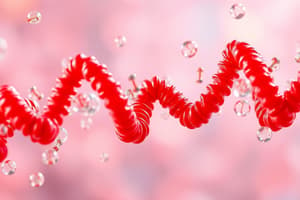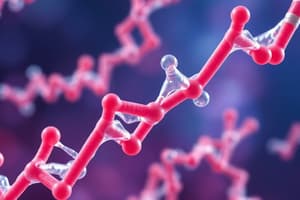Podcast
Questions and Answers
What is the primary storage form of carbohydrates in plants?
What is the primary storage form of carbohydrates in plants?
- Starch (correct)
- Fructose
- Cellulose
- Glycogen
What type of sugars are pentoses?
What type of sugars are pentoses?
- 4 carbon sugars
- 6 carbon sugars
- Monosaccharides with variable carbon count
- 5 carbon sugars (correct)
During the transcription process, which nucleotide pairs with Adenine in RNA?
During the transcription process, which nucleotide pairs with Adenine in RNA?
- Thymine
- Uracil (correct)
- Guanine
- Cytosine
Which of the following is an example of an oligosaccharide?
Which of the following is an example of an oligosaccharide?
What is the first step in the transcription process?
What is the first step in the transcription process?
Which purine is described as 2-amino-6-oxypurine?
Which purine is described as 2-amino-6-oxypurine?
Which of the following statements about recessive inheritance is true?
Which of the following statements about recessive inheritance is true?
What is the role of rifampicin in relation to RNA synthesis?
What is the role of rifampicin in relation to RNA synthesis?
What is the primary role of nucleic acids in biological systems?
What is the primary role of nucleic acids in biological systems?
Which enzyme is optimal at a temperature of 57°C?
Which enzyme is optimal at a temperature of 57°C?
Which type of DNA is characterized as having a left-handed helix?
Which type of DNA is characterized as having a left-handed helix?
In Koshland's Induced Fit Theory, what occurs when a substrate binds to an enzyme?
In Koshland's Induced Fit Theory, what occurs when a substrate binds to an enzyme?
Which component is NOT part of a nucleotide?
Which component is NOT part of a nucleotide?
Which of the following factors can inhibit enzyme activity?
Which of the following factors can inhibit enzyme activity?
What is the main reason for conformational changes in an enzyme during substrate binding?
What is the main reason for conformational changes in an enzyme during substrate binding?
Which metal ion is NOT listed as a common cofactor affecting enzyme activity?
Which metal ion is NOT listed as a common cofactor affecting enzyme activity?
What are the main products of fermentation?
What are the main products of fermentation?
Which types of glycogen storage diseases predominantly affect the liver?
Which types of glycogen storage diseases predominantly affect the liver?
Which of the following are considered the 4 P's of Diabetes Mellitus?
Which of the following are considered the 4 P's of Diabetes Mellitus?
What is a common symptom of Type 1 Diabetes Mellitus?
What is a common symptom of Type 1 Diabetes Mellitus?
What is the function of glucose transporters in cells?
What is the function of glucose transporters in cells?
What type of enzymes contain a non-protein group essential for their activity?
What type of enzymes contain a non-protein group essential for their activity?
How do enzymes affect the activation energy of a reaction?
How do enzymes affect the activation energy of a reaction?
Which theory suggests that the enzyme's active site is a perfect fit for the substrate?
Which theory suggests that the enzyme's active site is a perfect fit for the substrate?
What term describes non-protein molecules that assist with enzyme function?
What term describes non-protein molecules that assist with enzyme function?
What is formed when an enzyme binds to a substrate?
What is formed when an enzyme binds to a substrate?
Which of the following statements about enzymes is true?
Which of the following statements about enzymes is true?
Which enzyme class is primarily responsible for catalyzing the breakdown of compounds by adding water?
Which enzyme class is primarily responsible for catalyzing the breakdown of compounds by adding water?
What change occurs to enzymes when the pH level varies significantly?
What change occurs to enzymes when the pH level varies significantly?
What is the defining characteristic of epimers?
What is the defining characteristic of epimers?
Which of the following correctly describes polysaccharides?
Which of the following correctly describes polysaccharides?
Which agent is NOT effective in hydrolysis?
Which agent is NOT effective in hydrolysis?
What property describes reducing sugars?
What property describes reducing sugars?
Which common monosaccharides are considered epimers of each other?
Which common monosaccharides are considered epimers of each other?
How do monosaccharides and oligosaccharides typically appear?
How do monosaccharides and oligosaccharides typically appear?
Which statement about glycosaminoglycans (GAGs) is true?
Which statement about glycosaminoglycans (GAGs) is true?
What is the result of the hydrolysis of lactose?
What is the result of the hydrolysis of lactose?
Flashcards are hidden until you start studying
Study Notes
Enzyme Function and Characteristics
- Enzymes act as biological catalysts that accelerate chemical reactions.
- They are primarily proteins, though some are RNA (ribozymes).
- Function by lowering activation energy necessary for reactions.
Types of Enzymes
- Simple Proteins: Made only of amino acids.
- Conjugated Proteins: Contain non-protein components essential for activity, e.g., flavoproteins with FAD.
Properties of Enzymes
- Most are water-soluble and have pH-dependent activity.
- Require cofactors, often metal ions (e.g., zinc, magnesium) for effective function.
Mechanism of Action
- Enzymes form an enzyme-substrate complex upon binding with substrates.
- Transform substrates into products, releasing enzymes unchanged.
Activation Energy
- Enzymes lower the activation energy required for reactions, facilitating quicker catalysis.
Theories of Enzyme Action
- Lock and Key Theory: Active site perfectly fits the substrate.
- Induced Fit Theory: Enzyme adjusts shape to better accommodate the substrate.
Examples of Enzymes
- Synthetases: Catalyze compound synthesis.
- Ligases: Join two molecules.
- Hydrolases: Break down compounds using water.
Important Concepts
- Cofactors: Essential non-protein helpers.
- Prosthetic Groups: Tightly bound non-polypeptide units.
- Substrate: The reactant that binds to the enzyme.
Enzyme-Substrate Interaction
- Complementary structures enable enzyme-substrate binding.
- Binding leads to a catalytic reaction and product release.
Central Dogma of Molecular Biology
- Describes processes of DNA Replication, Transcription, and Translation.
Nucleic Acids Overview
- Store and transmit genetic information, with two main types:
- DNA: Contains genetic material; exists as a B-form under normal conditions.
- RNA: Involved in protein synthesis.
Structure of Nucleotides
- Composed of phosphate group, sugar (deoxyribose in DNA), and nitrogenous base.
- Nitrogenous bases categorized into pyrimidines (C, T, U) and purines (A, G).
Transcription Process
- Initiation: RNA polymerase binds to DNA to synthesize mRNA.
- Elongation: Nucleotides added to mRNA following base pairing rules.
- Termination: RNA polymerase detaches upon reaching a stop sequence.
Factors Affecting Enzyme Activity
- Concentrations of substrates and enzymes.
- Temperature influences; lactase optimal at 57°C, trypsin at 1.8°C.
- Presence of cofactors like metal ions.
- Inhibitors (e.g., antimetabolites like sulfanilamide) can hinder activity.
- Environmental pollutants (mercury, cadmium, lead) affect enzyme function.
Carbohydrates Overview
- Organic compounds made of carbon, hydrogen, and oxygen, providing energy.
- General formula: Cn(H2O)n.
Storage Forms of Carbohydrates
- Starch: Primary storage in plants.
- Glycogen: Storage form in animals.
Classification of Carbohydrates
- Monosaccharides: Simple sugars, e.g., ribose (pentose), glucose (hexose).
- Oligosaccharides: Short chains of monosaccharides.
- Polysaccharides: Long chains, e.g., starch and glycogen.
Properties of Carbohydrates
- Monosaccharides and oligosaccharides are typically white, crystalline solids, and water-soluble.
Biological Significance of Carbohydrates
- Play a vital role in energy storage, cell structure, and signaling.
Carbohydrate Deficiencies
- Marasmus: Result from carbohydrate deficiency leading to body shrinkage.
- Insulin regulates carbohydrate metabolism.
Diabetes Mellitus
- Type 1: Onset usually in childhood; often underweight.
- Type 2: Generally occurs in adults; often hereditary.
- Four key symptoms (the 4 P's): Polydipsia, Polyuria, Polyphagia, Persistence of non-healing wounds.
Pathologies of Diabetes
- Neuropathy: Impacts nerve functions.
- Nephropathy: Impairs kidney function.
- Retinopathy: Affects retina, potentially causing blindness.
Summary of Key Concepts
- Understanding enzyme characteristics and nucleic acid roles is vital for comprehending biological processes.
- Awareness of carbohydrate classifications and related health issues like diabetes aids in recognizing metabolic functions and disorders.
Studying That Suits You
Use AI to generate personalized quizzes and flashcards to suit your learning preferences.





